Ben Chen
Terahertz Signal Coverage Enhancement in Hall Scenarios Based on Single-Hop and Dual-Hop Reconfigurable Intelligent Surfaces
Dec 16, 2025Abstract:Terahertz (THz) communication offers ultra-high data rates and has emerged as a promising technology for future wireless networks. However, the inherently high free-space path loss of THz waves significantly limits the coverage range of THz communication systems. Therefore, extending the effective coverage area is a key challenge for the practical deployment of THz networks. Reconfigurable intelligent surfaces (RIS), which can dynamically manipulate electromagnetic wave propagation, provide a solution to enhance THz coverage. To investigate multi-RIS deployment scenarios, this work integrates an antenna array-based RIS model into the ray-tracing simulation platform. Using an indoor hall as a representative case study, the enhancement effects of single-hop and dual-hop RIS configurations on indoor signal coverage are evaluated under various deployment schemes. The developed framework offers valuable insights and design references for optimizing RIS-assisted indoor THz communication and coverage estimation.
SMILE: SeMantic Ids Enhanced CoLd Item Representation for Click-through Rate Prediction in E-commerce SEarch
Oct 14, 2025



Abstract:With the rise of modern search and recommendation platforms, insufficient collaborative information of cold-start items exacerbates the Matthew effect of existing platform items, challenging platform diversity and becoming a longstanding issue. Existing methods align items' side content with collaborative information to transfer collaborative signals from high-popularity items to cold-start items. However, these methods fail to account for the asymmetry between collaboration and content, nor the fine-grained differences among items. To address these issues, we propose SMILE, an item representation enhancement approach based on fused alignment of semantic IDs. Specifically, we use RQ-OPQ encoding to quantize item content and collaborative information, followed by a two-step alignment: RQ encoding transfers shared collaborative signals across items, while OPQ encoding learns differentiated information of items. Comprehensive offline experiments on large-scale industrial datasets demonstrate superiority of SMILE, and rigorous online A/B tests confirm statistically significant improvements: item CTR +1.66%, buyers +1.57%, and order volume +2.17%.
InfoGain-RAG: Boosting Retrieval-Augmented Generation via Document Information Gain-based Reranking and Filtering
Sep 16, 2025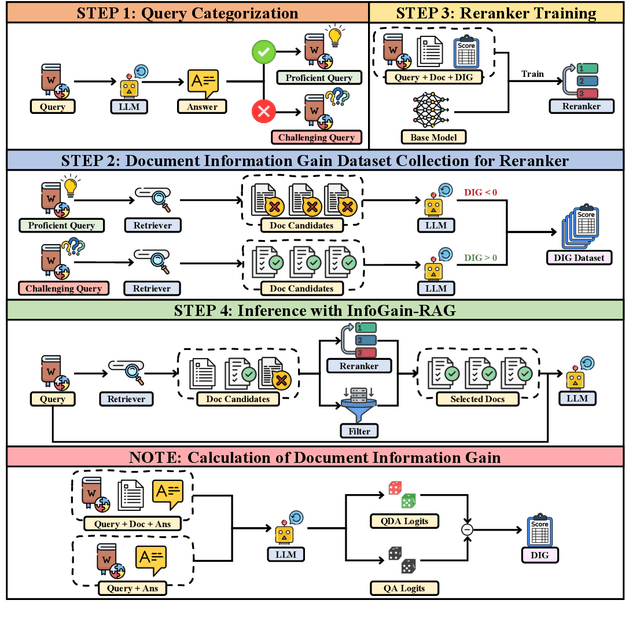
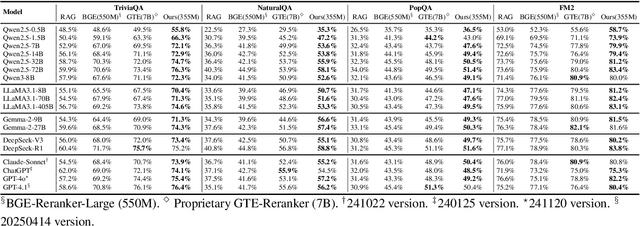
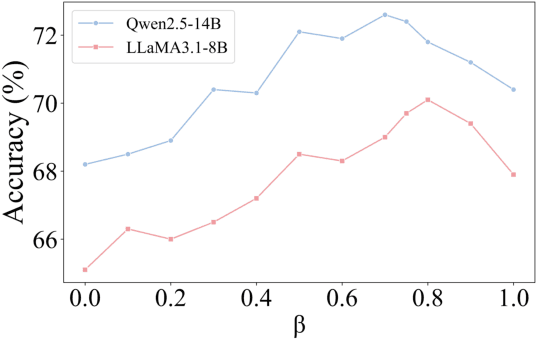
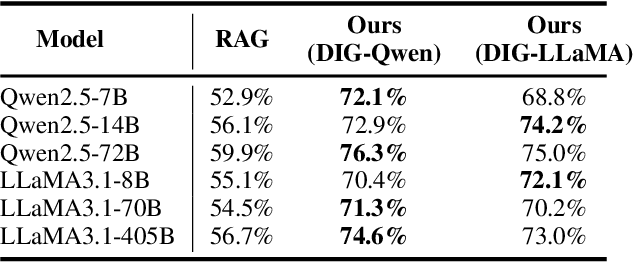
Abstract:Retrieval-Augmented Generation (RAG) has emerged as a promising approach to address key limitations of Large Language Models (LLMs), such as hallucination, outdated knowledge, and lacking reference. However, current RAG frameworks often struggle with identifying whether retrieved documents meaningfully contribute to answer generation. This shortcoming makes it difficult to filter out irrelevant or even misleading content, which notably impacts the final performance. In this paper, we propose Document Information Gain (DIG), a novel metric designed to quantify the contribution of retrieved documents to correct answer generation. DIG measures a document's value by computing the difference of LLM's generation confidence with and without the document augmented. Further, we introduce InfoGain-RAG, a framework that leverages DIG scores to train a specialized reranker, which prioritizes each retrieved document from exact distinguishing and accurate sorting perspectives. This approach can effectively filter out irrelevant documents and select the most valuable ones for better answer generation. Extensive experiments across various models and benchmarks demonstrate that InfoGain-RAG can significantly outperform existing approaches, on both single and multiple retrievers paradigm. Specifically on NaturalQA, it achieves the improvements of 17.9%, 4.5%, 12.5% in exact match accuracy against naive RAG, self-reflective RAG and modern ranking-based RAG respectively, and even an average of 15.3% increment on advanced proprietary model GPT-4o across all datasets. These results demonstrate the feasibility of InfoGain-RAG as it can offer a reliable solution for RAG in multiple applications.
OneSug: The Unified End-to-End Generative Framework for E-commerce Query Suggestion
Jun 07, 2025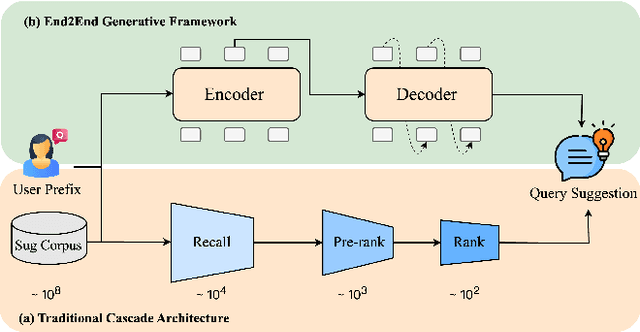
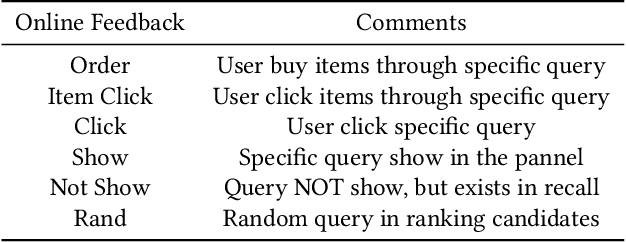

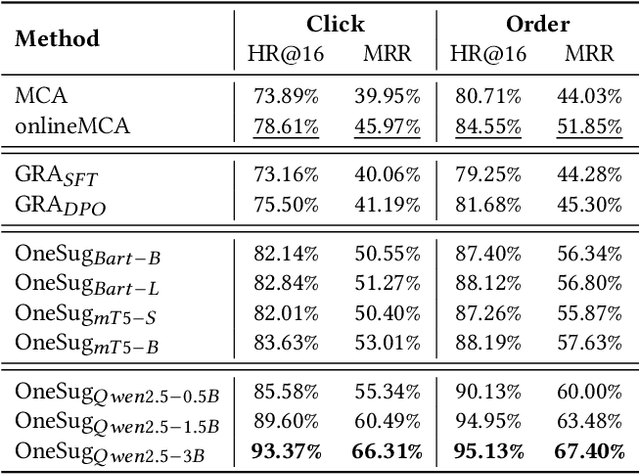
Abstract:Query suggestion plays a crucial role in enhancing user experience in e-commerce search systems by providing relevant query recommendations that align with users' initial input. This module helps users navigate towards personalized preference needs and reduces typing effort, thereby improving search experience. Traditional query suggestion modules usually adopt multi-stage cascading architectures, for making a well trade-off between system response time and business conversion. But they often suffer from inefficiencies and suboptimal performance due to inconsistent optimization objectives across stages. To address these, we propose OneSug, the first end-to-end generative framework for e-commerce query suggestion. OneSug incorporates a prefix2query representation enhancement module to enrich prefixes using semantically and interactively related queries to bridge content and business characteristics, an encoder-decoder generative model that unifies the query suggestion process, and a reward-weighted ranking strategy with behavior-level weights to capture fine-grained user preferences. Extensive evaluations on large-scale industry datasets demonstrate OneSug's ability for effective and efficient query suggestion. Furthermore, OneSug has been successfully deployed for the entire traffic on the e-commerce search engine in Kuaishou platform for over 1 month, with statistically significant improvements in user top click position (-9.33%), CTR (+2.01%), Order (+2.04%), and Revenue (+1.69%) over the online multi-stage strategy, showing great potential in e-commercial conversion.
Use Cases for Terahertz Communications: An Industrial Perspective
Jan 07, 2025



Abstract:Thanks to the vast amount of available resources and unique propagation properties, terahertz (THz) frequency bands are viewed as a key enabler for achieving ultrahigh communication performance and precise sensing capabilities in future wireless systems. Recently, the European Telecommunications Standards Institute (ETSI) initiated an Industry Specification Group (ISG) on THz which aims at establishing the technical foundation for subsequent standardization of this technology, which is pivotal for its successful integration into future networks. Starting from the work recently finalized within this group, this paper provides an industrial perspective on potential use cases and frequency bands of interest for THz communication systems. We first identify promising frequency bands in the 100 GHz - 1 THz range, offering over 500 GHz of available spectrum that can be exploited to unlock the full potential of THz communications. Then, we present key use cases and application areas for THz communications, emphasizing the role of this technology and its advantages over other frequency bands. We discuss their target requirements and show that some applications demand for multi-Tbps data rates, latency below 0.5 ms, and sensing accuracy down to 0.5 cm. Additionally, we identify the main deployment scenarios and outline other enabling technologies crucial for overcoming the challenges faced by THz system. Finally, we summarize the past and ongoing standardization efforts focusing on THz communications, while also providing an outlook towards the inclusion of this technology as an integral part of the future sixth generation (6G) and beyond communication networks.
MoDULA: Mixture of Domain-Specific and Universal LoRA for Multi-Task Learning
Dec 10, 2024
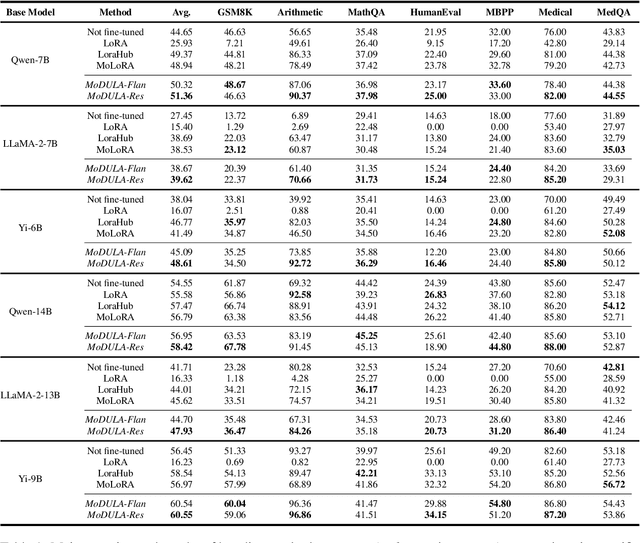
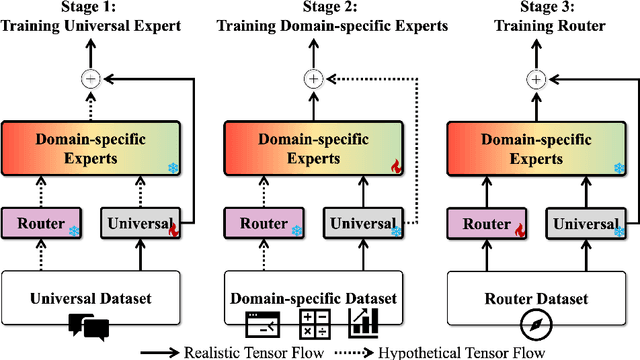
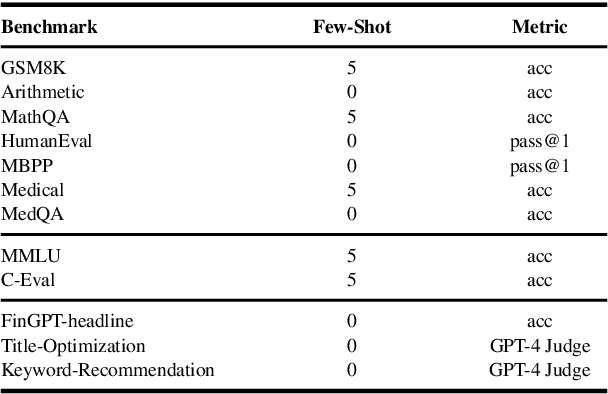
Abstract:The growing demand for larger-scale models in the development of \textbf{L}arge \textbf{L}anguage \textbf{M}odels (LLMs) poses challenges for efficient training within limited computational resources. Traditional fine-tuning methods often exhibit instability in multi-task learning and rely heavily on extensive training resources. Here, we propose MoDULA (\textbf{M}ixture \textbf{o}f \textbf{D}omain-Specific and \textbf{U}niversal \textbf{L}oR\textbf{A}), a novel \textbf{P}arameter \textbf{E}fficient \textbf{F}ine-\textbf{T}uning (PEFT) \textbf{M}ixture-\textbf{o}f-\textbf{E}xpert (MoE) paradigm for improved fine-tuning and parameter efficiency in multi-task learning. The paradigm effectively improves the multi-task capability of the model by training universal experts, domain-specific experts, and routers separately. MoDULA-Res is a new method within the MoDULA paradigm, which maintains the model's general capability by connecting universal and task-specific experts through residual connections. The experimental results demonstrate that the overall performance of the MoDULA-Flan and MoDULA-Res methods surpasses that of existing fine-tuning methods on various LLMs. Notably, MoDULA-Res achieves more significant performance improvements in multiple tasks while reducing training costs by over 80\% without losing general capability. Moreover, MoDULA displays flexible pluggability, allowing for the efficient addition of new tasks without retraining existing experts from scratch. This progressive training paradigm circumvents data balancing issues, enhancing training efficiency and model stability. Overall, MoDULA provides a scalable, cost-effective solution for fine-tuning LLMs with enhanced parameter efficiency and generalization capability.
Contrastive Token Learning with Similarity Decay for Repetition Suppression in Machine Translation
Sep 30, 2024



Abstract:For crosslingual conversation and trade, Neural Machine Translation (NMT) is pivotal yet faces persistent challenges with monotony and repetition in generated content. Traditional solutions that rely on penalizing text redundancy or token reoccurrence have shown limited efficacy, particularly for lengthy article and e-commerce descriptions with inherent redundancy, even with the advent of Large Language Models (LLMs). This paper investigates the underlying causes of textual repetition through the lens of information entropy, attributing the phenomenon to the elevated uncertainty within the input text. To address this, a novel algorithm named Contrastive Token Learning with Similarity Decay (CTSD) is introduced, which modulates the suppression of tokens dynamically, informed by varying attention weights and inter-token distances. Furthermore, an e-commerce dataset comprised of title texts of online real items is compiled and released susceptible to hallucination translations to benchmark the algorithm. Extensive evaluations demonstrate that CTSD significantly outperforms existing approaches in precision and generalizability. Additional online A/B testing underscores its practical value, showing marked improvements in user engagement and conversion. Notably, this method has been implemented with full traffic on eight multilingual sites of alibaba.com, the largest B2B e-commerce platform in the world.
UV-Mamba: A DCN-Enhanced State Space Model for Urban Village Boundary Identification in High-Resolution Remote Sensing Images
Sep 05, 2024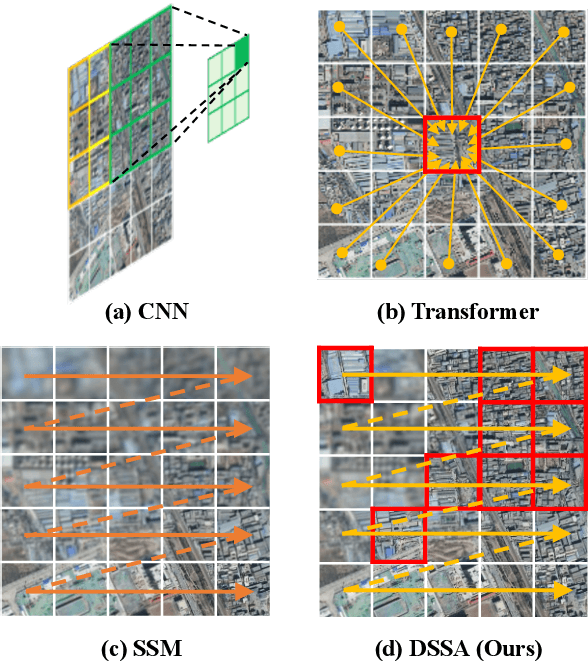
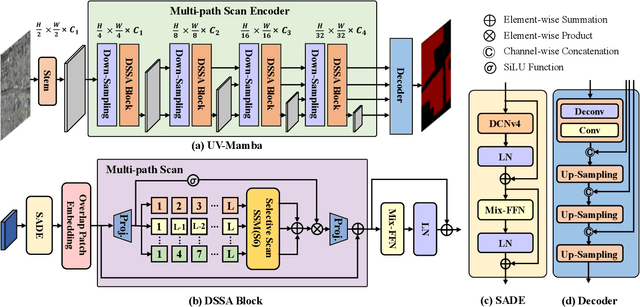


Abstract:Owing to the diverse geographical environments, intricate landscapes, and high-density settlements, the automatic identification of urban village boundaries using remote sensing images is a highly challenging task. This paper proposes a novel and efficient neural network model called UV-Mamba for accurate boundary detection in high-resolution remote sensing images. UV-Mamba mitigates the memory loss problem in long sequence modeling, which arises in state space model (SSM) with increasing image size, by incorporating deformable convolutions (DCN). Its architecture utilizes an encoder-decoder framework, includes an encoder with four deformable state space augmentation (DSSA) blocks for efficient multi-level semantic extraction and a decoder to integrate the extracted semantic information. We conducted experiments on the Beijing and Xi'an datasets, and the results show that UV-Mamba achieves state-of-the-art performance. Specifically, our model achieves 73.3% and 78.1% IoU on the Beijing and Xi'an datasets, respectively, representing improvements of 1.2% and 3.4% IoU over the previous best model, while also being 6x faster in inference speed and 40x smaller in parameter count. Source code and pre-trained models are available in the supplementary material.
Robust Interaction-based Relevance Modeling for Online E-Commerce and LLM-based Retrieval
Jun 04, 2024Abstract:Semantic relevance calculation is crucial for e-commerce search engines, as it ensures that the items selected closely align with customer intent. Inadequate attention to this aspect can detrimentally affect user experience and engagement. Traditional text-matching techniques are prevalent but often fail to capture the nuances of search intent accurately, so neural networks now have become a preferred solution to processing such complex text matching. Existing methods predominantly employ representation-based architectures, which strike a balance between high traffic capacity and low latency. However, they exhibit significant shortcomings in generalization and robustness when compared to interaction-based architectures. In this work, we introduce a robust interaction-based modeling paradigm to address these shortcomings. It encompasses 1) a dynamic length representation scheme for expedited inference, 2) a professional terms recognition method to identify subjects and core attributes from complex sentence structures, and 3) a contrastive adversarial training protocol to bolster the model's robustness and matching capabilities. Extensive offline evaluations demonstrate the superior robustness and effectiveness of our approach, and online A/B testing confirms its ability to improve relevance in the same exposure position, resulting in more clicks and conversions. To the best of our knowledge, this method is the first interaction-based approach for large e-commerce search relevance calculation. Notably, we have deployed it for the entire search traffic on alibaba.com, the largest B2B e-commerce platform in the world.
A Parallel Attention Network for Cattle Face Recognition
Mar 29, 2024



Abstract:Cattle face recognition holds paramount significance in domains such as animal husbandry and behavioral research. Despite significant progress in confined environments, applying these accomplishments in wild settings remains challenging. Thus, we create the first large-scale cattle face recognition dataset, ICRWE, for wild environments. It encompasses 483 cattle and 9,816 high-resolution image samples. Each sample undergoes annotation for face features, light conditions, and face orientation. Furthermore, we introduce a novel parallel attention network, PANet. Comprising several cascaded Transformer modules, each module incorporates two parallel Position Attention Modules (PAM) and Feature Mapping Modules (FMM). PAM focuses on local and global features at each image position through parallel channel attention, and FMM captures intricate feature patterns through non-linear mappings. Experimental results indicate that PANet achieves a recognition accuracy of 88.03% on the ICRWE dataset, establishing itself as the current state-of-the-art approach. The source code is available in the supplementary materials.
 Add to Chrome
Add to Chrome Add to Firefox
Add to Firefox Add to Edge
Add to Edge